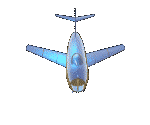



A Short 4477th Unit History Cont.
While initially RED EAGLE MiG pilots also flew mission aircraft at Nellis such as Aggressor F-5Es or Weapons
School F-4Es, F-16s and F-15s, RED EAGLE pilots eventually evolved into logging time and taking check rides for
their proficiency requirements in the assigned T-38s. As an added benefit the T-38s enabled the unit to fly VIP
orientations and provide incentive flights for the people assigned to the TTR (both MiG and F-117 personnel).
The unit also had a small fleet of civilian light twin aircraft (Cessna 404s later replaced by Mitsubishi
MU-2s) that were used for transportation, mostly between Nellis and TTR. RED EAGLE pilots flew the light twins.
The light twins were eventually phased out in favor of AF C-12s flown by non-project military pilots.
The MiG-17s were retired in 1981 after an engine problem prompted Capt Mark Postai to crash land in the
desert. He stated after escaping uninjured that it was a very rough ride and something he would not likely do again.
The drawdown of the MiG-17 fleet corresponded with the introduction of the MiG-23 Flogger and the acquisition
of additional MiG-21s. At the peak the 4477
th
had 17 MiG-21s and 10 MiG-23s.
The buildup of the MiG fleet was accompanied by increased number of personnel assigned along with the
acquisition of, and in some cases, the manufacture of additional surface vehicles.
The manufacture claim is a bit of a stretch. Those vehicles were combinations of various hulks that the RED
EAGLES acquired from Defense Reutilization Management Offices (DRMO or salvage yard in the old days)
throughout the west.
A RED EAGLE vehicle mechanic by the name of Billy Lightfoot led the way with the “manufactured” vehicles.
More than once a senior officer asked about that redheaded, long haired little man with a “Yosemite Sam” like
moustache who was driving that weird vehicle.
Other RED EAGLE geniuses built a TV station with satellite downlinks for the entertainment of the RED EAGLES
that worked late and stayed on the site overnight. Most of the major parts were obtained from the DRMO.
An overseas trip harvested two self-propelled Russian aircraft starting trucks. They were in terrible shape, but our
men restored these relics and greatly improved the efficiency on the flight line.
It took manpower to restore and operate the large fleet and the initial cadre of officers and enlisted personnel
grew significantly over the lifetime of the program.
As the program matured, so did our support philosophy. It evolved from "finding, procuring, restoring and
maintaining" a few single items, to a full-up, formal system that "procured and supported" an entire squadron's
requirements using the spectrum of USAF support capabilities. Thus, our small initial cadre eventually evolved into
an organization requiring the support of hundreds, both internally and externally!
We lost three RED EAGLES during the program period. LT (USN) Hugh Brown was killed in the crash of a MiG-
17 and Capt Mark Postai was killed in the crash of a MiG-23. TSgt Rey Hernandez, a fuels specialist, died as a
result of injuries from an industrial incident relating to the repair of a fuel cell in a RED EAGLE T-38.
Is there more to this history? You bet! Steve Davies has chronicled a historical study in his book titled, RED
EAGLES, America’s Secret MiGs and Gail Peck has written more of an insider’s story about the RED EAGLES that
is titled America’s SECRET MiG Squadron. At last report both books are still available on www.Amazon.com
Our goal is a comprehensive history that matches pilots and mechanics to specific MiGs and T-38s by tail
number. A similar report on the contributions of our other personnel is also warranted. Some feeble starts have been
made to research the details and hopefully that task will gather traction before we all get too old to
remember the details. STANDBY and be ready! The CALL for help will come.
























